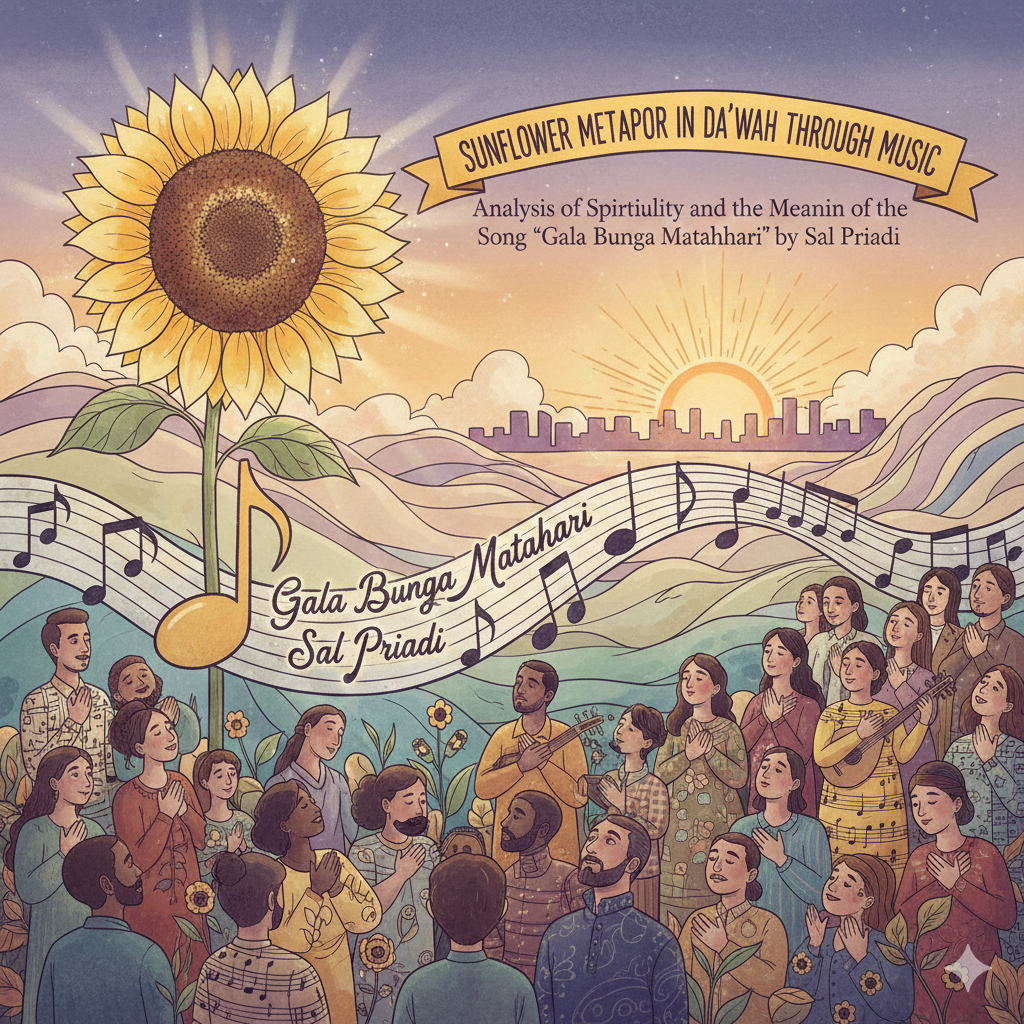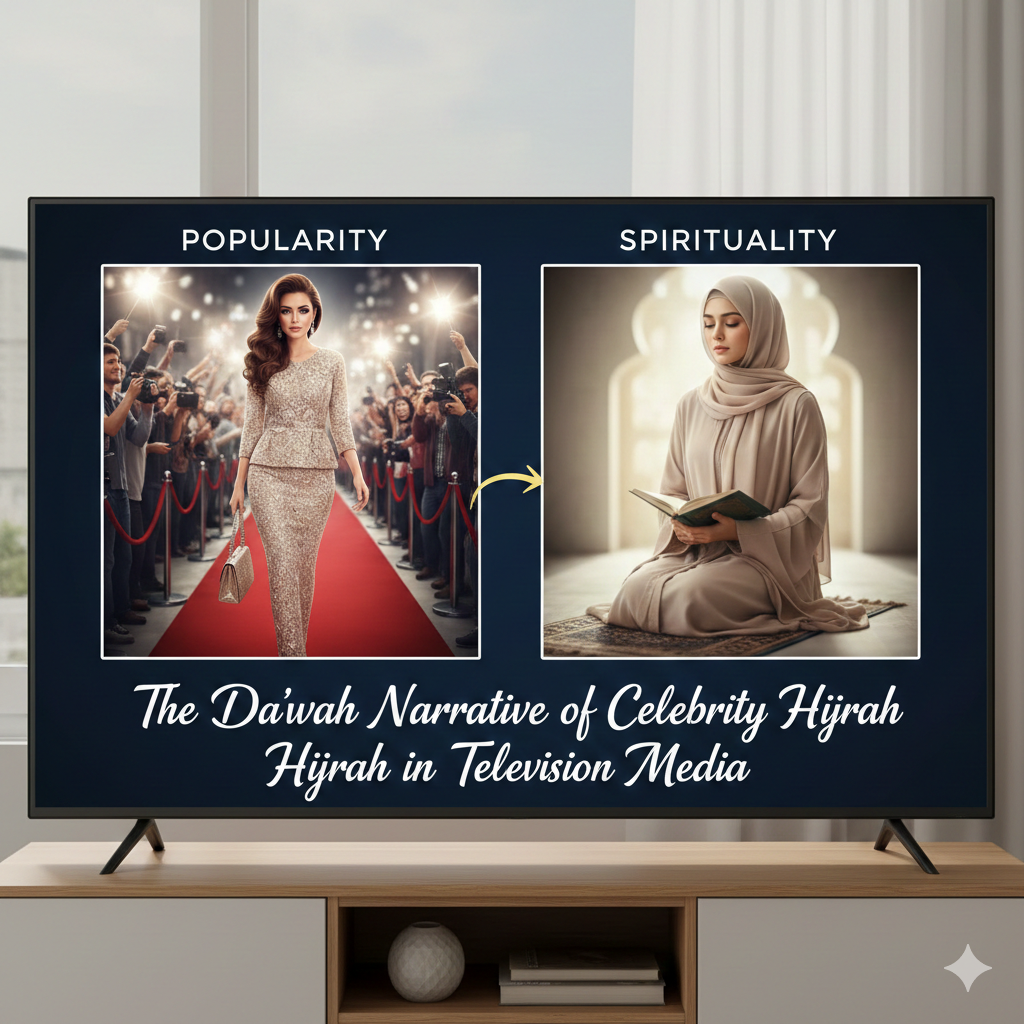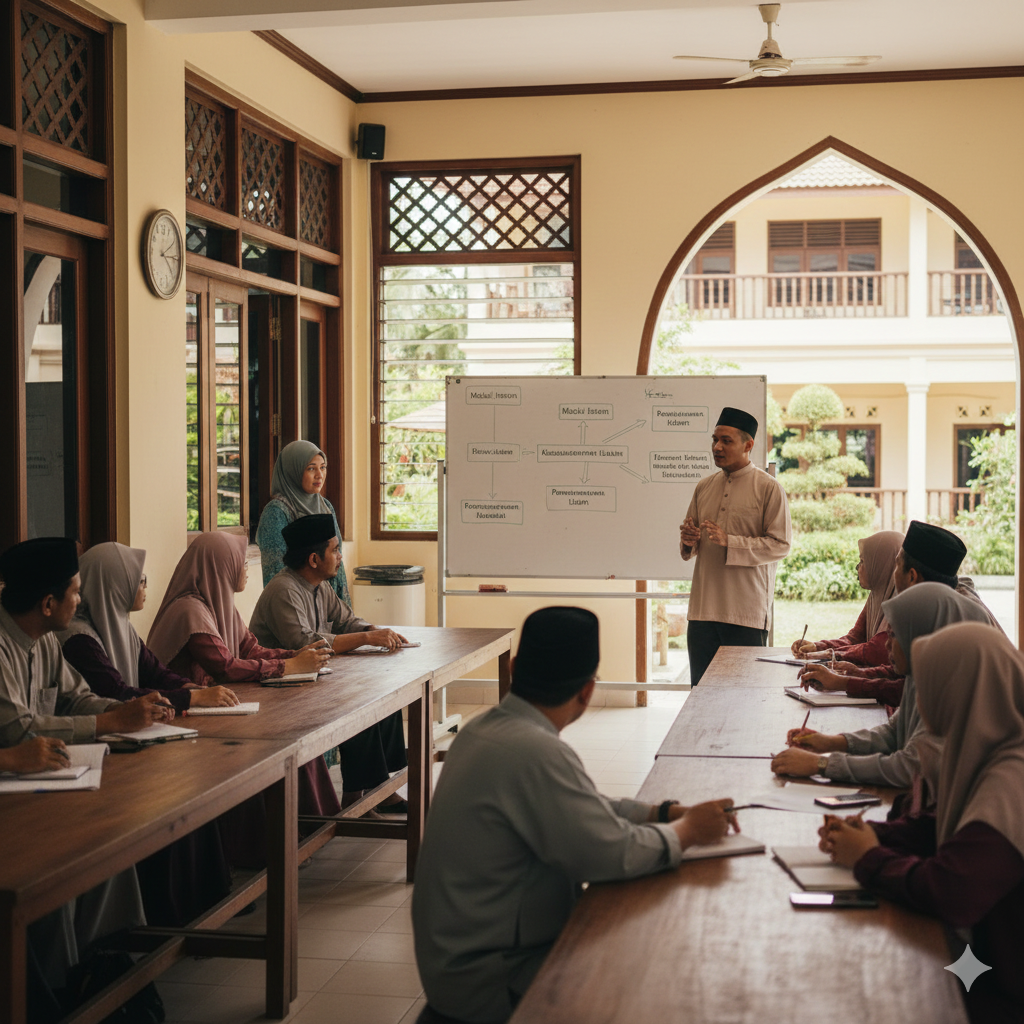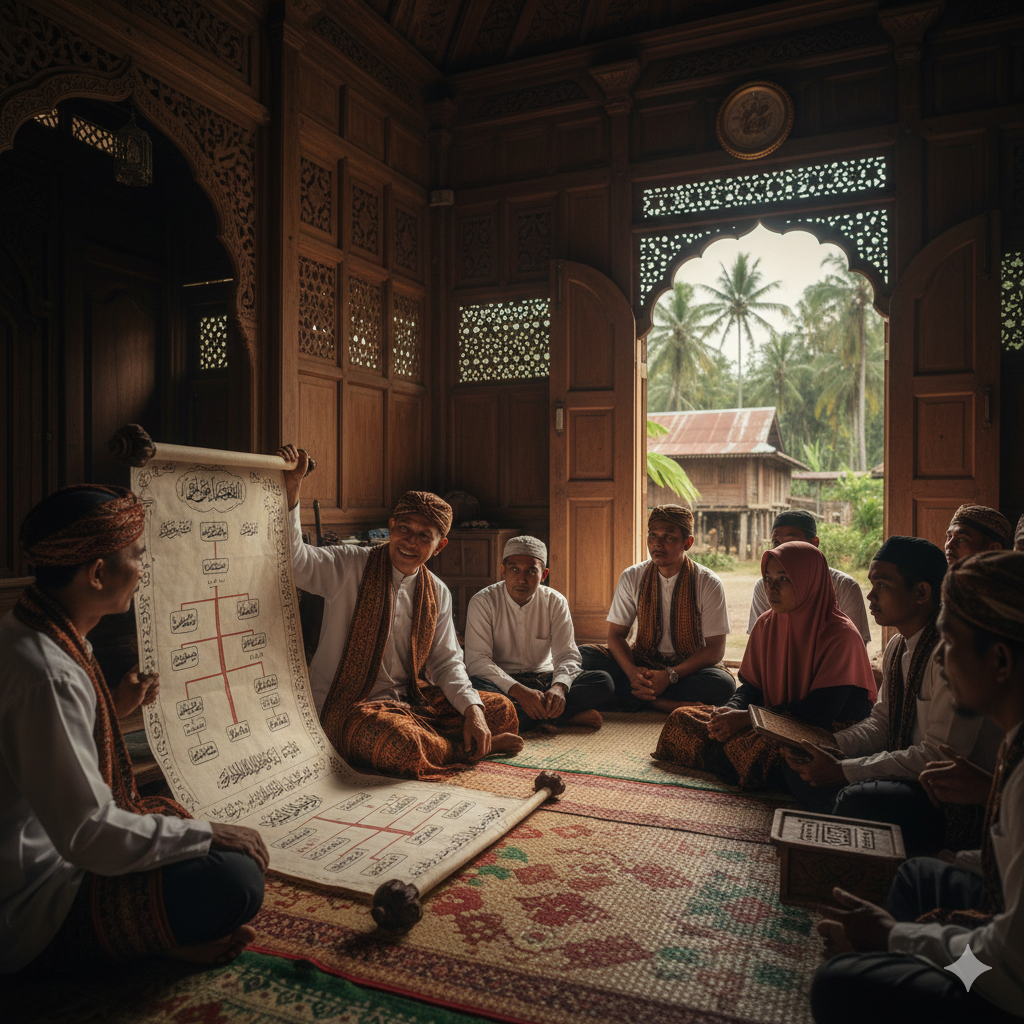SUNFLOWER METAPHOR IN DA'WAH THROUGH MUSIC
Analysis of Spirituality and the Meaning of the Song 'Gala Bunga Matahari' by Sal Priadi

Downloads
This study explores da'wah's spiritual and communicative aspects embedded in Sal Priadi's song "Gala Bunga Matahari." The research investigates how the sunflower metaphor is employed to convey themes of loss, hope, and emotional resilience in the context of da'wah through music. Utilizing a qualitative method with textual analysis, the study delves into the lyrical content to uncover the spiritual messages conveyed. The findings indicate that the song effectively serves as a medium for da'wah, facilitating spiritual reflection and providing solace to its listeners. The study concludes that music, as exemplified in this song, can significantly convey da'wah messages by addressing profound emotional and spiritual experiences.
[Penelitian ini bertujuan untuk mengeksplorasi aspek spiritual dan komunikatif dakwah yang tertanam dalam lagu "Gala Bunga Matahari" karya Sal Priadi. Penelitian ini menyelidiki bagaimana metafora bunga matahari digunakan untuk menyampaikan tema kehilangan, harapan, dan ketahanan emosional dalam konteks dakwah melalui musik. Dengan menggunakan metode kualitatif melalui analisis teks, penelitian ini mengkaji isi lirik untuk mengungkap pesan spiritual yang disampaikan. Temuan menunjukkan bahwa lagu ini secara efektif berfungsi sebagai media dakwah, memfasilitasi refleksi spiritual dan memberikan penghiburan kepada pendengarnya. Penelitian ini menyimpulkan bahwa musik, seperti yang dicontohkan dalam lagu ini, dapat berperan signifikan dalam menyampaikan pesan dakwah dengan mengatasi pengalaman emosional dan spiritual yang mendalam].
Agustiana, Irma, and Gilang H. Asshidiqi. 'Internalization of Madrasah Cultural Values as a Means of Strengthening Character Education in MTsN 2 Banyuwangi'. Al Hikmah Journal of Education 2, no. 1 (2021): 53–68. https://doi.org/10.54168/ahje.v2i1.33.
Agustina, Wanda I. 'Semiotic Analysis of the Meaning of Longing in the Lyrics of the Song "Gala Bunga Matahari" by Sal Priadi.' Eduinovasi Journal of Basic Educational Studies 4, no. 2 (2024): 1256–69. https://doi.org/10.47467/edu.v4i2.4229.
Ahmad, Yousef B., and Siti G. Attas. 'The Meaning of Siloka (Philosophical) Lyrics of the Karawang Goyang Song by Lingga Angling Raspati.' Judika (Unsika Education Journal) 10, no. 1 (2022): 33–42. https://doi.org/10.35706/judika.v10i1.5939.
Ardana, Retno Anggraini Tri, and Poppy Febriana. 'Analysis of the Phenomenon of Using Tiktok Social Media @duniaislam2 as a Da'wah Media'. Academician Globe: Inderscience Research 2, no. 4 (3 October 2023). https://doi.org/10.47134/academicia.v2i4.7.
Dzarna, Dzarna. 'Madura Songs as a Media for Cultural Introduction (Critical Discourse and Review).' Calls (Journal of Culture Arts Literature and Linguistics) 8, no. 2 (2022): 147. https://doi.org/10.30872/calls.v8i2.7445.
Ghaliyah, Bunga D. N. 'Da'wah Through Cianjuran Sundanese Songs.' Dewa Ruci Journal of Art Studies and Creation 12, no. 2 (2017): 40–50. https://doi.org/10.33153/dewaruci.v12i2.2519.
Hanif, Abdulloh. 'The Dimension of Musical Spirituality as a Medium of Existence in Jalaluddin Rumi's Sufism.' Fitua Journal of Islamic Studies 4, no. 2 (2023): 111–28. https://doi.org/10.47625/fitua.v4i2.508.
Huda, Nor, Wahyu Amni, and Fitriah Fitriah. 'Indonesian Muslim Artists and Cultural Institutions: Its Role in the Development of Islamic Culture in Indonesia in the Era of 1962-1967 AD'. Tanjak History and Islamic Civilization 2, no. 1 (2022): 97–107. https://doi.org/10.19109/tanjak.v2i1.11979.
Indriyani, Dewi. 'Semiotic Analysis in the Lyrics of the Song "Amin Most Serious" by Sal Priadi & Nadin Amizah.' Prawara Journal of Indonesian Language and Literature Education 5, no. 1 (2024): 1. https://doi.org/10.20884/1.jpbsi.2024.5.1.10322.
Islami, Selvy N. 'Reading Generation Z's Loneliness Trend in the Heart Guard Song: An Analysis of Norman Fairclough's Critical Discourse.' Bastrindo Journal 4, no. 2 (2023): 170–86. https://doi.org/10.29303/jb.v4i2.1368.
Ismiyatin, Laela, and Miftakhul Huda. 'Hermeneutic Analysis of Rossa's Song Representing the Voice of Women's Conscience.' Paraphrasing Journal of Language & Literature Studies 21, no. 1 (2021). https://doi.org/10.30996/parafrase.v21i1.4616.
Khafi, Akhmad A. D. 'Semiotic Analysis of the Video of Sal Men Intimate in the Past.' Jbdi 1, no. 1 (2024): 18. https://doi.org/10.47134/jbdi.v1i1.2710.
Khopipah, Tsania S. 'The Connection of Music and Lyrics in Sacred Songs by Rhoma Irama.' Swara 3, no. 1 (2023): 61–70. https://doi.org/10.17509/swara.v3i1.57817.
Morning, Imanuela I. P. 'Musicological Study, O Lord, Our God and Our Father Who Is in Heaven in the Book Sing a New Song for God.' Tonika Journal of Art Research and Studies 6, no. 1 (2023): 28–39. https://doi.org/10.37368/tonika.v6i1.522.
Muthalib, A. 'The History of the Development of Indonesian Islam in the Modern Era 1945-2021'. Education 9, no. 1 (2021): 1–14. https://doi.org/10.32520/judek.v9i1.1540.
Nurhidayah, Shopa'a A., Dyah Lyesnaya, and Iis Nurasiah. 'The Effect of the Use of Wayang Sukuraga Application on the Therapy of Writing Narratives of Lower Grade Students.' Journal for Lesson and Learning Studies 5, no. 1 (2022): 157–63. https://doi.org/10.23887/jlls.v5i1.48711.
Purnomo, Bitoh. 'Analysis of MUI Fatwa in the Covid-19 Period in the Perspective of Ushul Fiqih'. Reason 1, no. 2 (2023): 120–30. https://doi.org/10.61461/nlr.v1i2.37.
Saraswati, Dyah P., Nur I. Subono, and Friska Melani. 'A Form of Women's Resistance Through Writing in Our World Album and Salam Harapan.' Journal of Humanities Research 26, no. 2 (2022): 89–104. https://doi.org/10.21831/hum.v26i2.45473.
Setiawati, Ambarul M., Dara M. Ayu, Sinta Wulandari, and Vita A. Putri. 'Analysis of Language Style in the Lyrics of Nadin Amizah's "Bertaut" Song: A Stylistic Study.' Journal of Humanities Research 26, no. 1 (2021): 26–37. https://doi.org/10.21831/hum.v26i1.41373.
Sitinjak, Dina K. 'The Meaning of Traditional Game Songs of Martumba Culture in Sanggar Jolo New Samosir'. Grenek Music Journal 12, no. 1 (2023): 24. https://doi.org/10.24114/grenek.v12i1.44233.
Suhermanto, Satya R. 'Language Style in Song Lyrics Later We Are Like This: A Semantic Study.' West Science Education Journal 1, no. 12 (2023): 782–88. https://doi.org/10.58812/jpdws.v1i12.834.
Tiara Nur Alifah Intan Cilvia. 'The Role of Themistic-Based Children's Songs in English Learning for Kindergarten A Children.' Murhum Journal of Early Childhood Education 4, no. 2 (2023): 756–69. https://doi.org/10.37985/murhum.v4i2.387.
Viani, Fadia. ‘Adaptasi Bunga Narcissus Pada Busana Kreasi’. Action Research Literate 8, no. 3 (2024): 561–68. https://doi.org/10.46799/arl.v8i3.328.
Viola Rezkhika Aulia Putri Kurnia Viola. 'The Meaning of Motivation in the Lyrics of the Song "Diri" by Tulus.' Bandung Conference Series Public Relations 3, no. 2 (2023): 721–33. https://doi.org/10.29313/bcspr.v3i2.8981.
Winurrahman, Affan H. 'Representation of Rejection of Mainstream Beauty Standards in King Song by Charisma.' Journal of Media and Communication 4, no. 1 (2023): 62–79. https://doi.org/10.20473/medkom.v4i1.49416.
Yuniswara, Ernestine O., and Nurul Hartini. 'Lyric Analysis Intervention: Overcoming the Cognitive Rumination of Late Adolescent Girls with BTS Song Lyrics.' Insan Journal of Psychology and Mental Health 7, no. 1 (2022): 68–97. https://doi.org/10.20473/jpkm.v7i12022.68-97.
Copyright (c) 2024 Putri Isma Indriyani, Makrifatul Illah

This work is licensed under a Creative Commons Attribution-NonCommercial 4.0 International License.
Authors who publish with this journal agree to the following terms:
- Authors retain copyright and grant the journal right of first publication with the work simultaneously licensed under a Creative Commons Attribution License that allows others to share the work with an acknowledgement of the work's authorship and initial publication in this journal.
- Authors are able to enter into separate, additional contractual arrangements for the non-exclusive distribution of the journal's published version of the work (e.g., post it to an institutional repository or publish it in a book), with an acknowledgement of its initial publication in this journal.
- Authors are permitted and encouraged to post their work online (e.g., in institutional repositories or on their website) prior to and during the submission process, as it can lead to productive exchanges, as well as earlier and greater citation of published work (See The Effect of Open Access).









